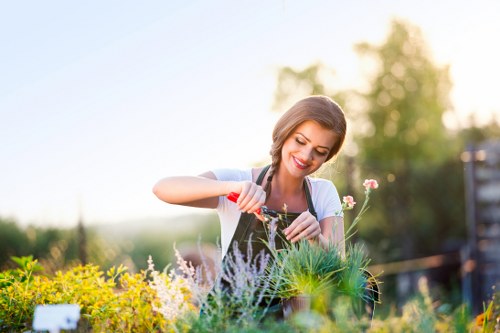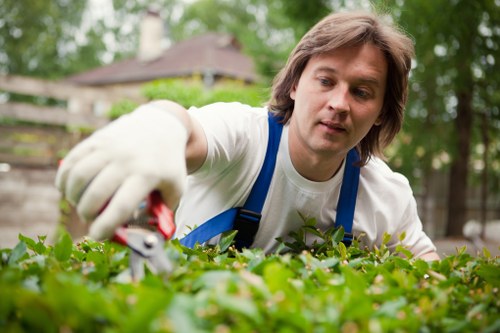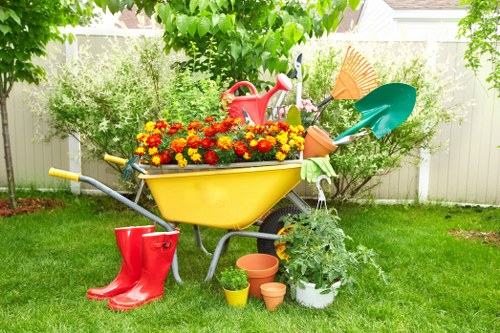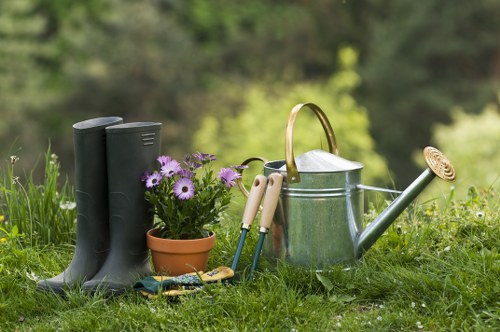Landscape Gardeners Maze Hill

Located in the heart of London, Maze Hill is renowned for its stunning landscapes and serene gardens. Whether you're a seasoned gardener or a beginner, finding the right landscape gardener is essential to transform your outdoor space into a haven of beauty and tranquility.
Landscape gardeners in Maze Hill specialize in creating bespoke garden designs that cater to individual tastes and the unique characteristics of each property. From selecting the perfect plants to designing intricate layouts, these professionals ensure that every aspect of your garden is thoughtfully considered.
One of the key advantages of hiring a local landscape gardener is their familiarity with the local climate and soil conditions. This knowledge allows them to choose plants that will thrive in Maze Hill's environment, ensuring a lush and vibrant garden all year round.

Services Offered by Landscape Gardeners in Maze Hill
Landscape gardeners offer a wide range of services to cater to various gardening needs. Here are some of the primary services you can expect:
- Garden Design: Crafting detailed garden layouts that align with your vision and the natural features of your property.
- Plant Selection: Choosing the right plants that complement each other and thrive in your garden's conditions.
- Maintenance: Regular upkeep services to keep your garden healthy and looking its best.
- Hardscaping: Installing elements like patios, walkways, and retaining walls to enhance the structure of your garden.
- Lighting: Designing and installing garden lighting to highlight key features and extend usability into the evening hours.
Each of these services is tailored to meet the specific needs of your garden, ensuring a cohesive and harmonious outdoor space.

Garden Design and Planning
A well-designed garden enhances the aesthetic appeal and functional value of your property. Landscape gardeners in Maze Hill work closely with clients to understand their preferences and requirements, ensuring that the final design is both beautiful and practical.
In the planning phase, considerations such as sunlight exposure, soil type, drainage, and existing structures are taken into account. This thorough approach ensures that the garden not only looks good but is also sustainable and easy to maintain.
Custom features like patios, water features, or pergolas can be incorporated into the design to add unique elements that reflect your personal style.
Moreover, landscaping professionals often use 3D modeling and virtual tours to help clients visualize the end result, allowing for adjustments and refinements before the actual implementation begins.
Effective garden design balances beauty with functionality, creating spaces that are enjoyable for relaxation, entertainment, and even gardening activities.

Plant Selection and Installation
Selecting the right plants is crucial for creating a thriving garden. Landscape gardeners have an in-depth knowledge of various plant species and their growth patterns, ensuring that each plant is placed in the optimal location.
They consider factors such as light requirements, water needs, and compatibility with other plants to create a balanced and cohesive garden ecosystem.
Proper installation techniques are employed to ensure that plants establish well and contribute to the overall health and beauty of the garden.
Seasonal flowering plants are strategically placed to ensure year-round color and interest, while native plants are often preferred for their resilience and low maintenance needs.
Additionally, gardeners may incorporate edible plants, allowing homeowners to enjoy fresh produce alongside ornamental beauty.

Garden Maintenance
Maintenance is key to preserving the health and appearance of your garden. Regular maintenance services include pruning, weeding, fertilizing, and pest control, among others.
Landscape gardeners develop customized maintenance plans based on the specific needs of your garden, ensuring that it remains vibrant and well-kept throughout the year.
Investing in professional maintenance not only enhances the longevity of your garden but also allows you to enjoy a beautiful outdoor space without the hassle of upkeep.
Scheduled maintenance visits can prevent minor issues from becoming major problems, saving time and resources in the long run.
Moreover, professional gardeners can provide valuable advice on plant care, seasonal adjustments, and sustainable practices to keep your garden flourishing.
Why Choose a Local Landscape Gardener in Maze Hill?
Opting for a local landscape gardener in Maze Hill comes with several benefits:
- Local Expertise: Understanding of local climate, soil, and plant varieties.
- Personalized Service: Tailored solutions that meet the specific needs of your garden.
- Convenience: Easy access for in-person consultations and timely service delivery.
- Community Knowledge: Familiarity with local regulations, community standards, and sustainable practices.
- Ongoing Support: Reliable local presence for maintenance and future garden enhancements.
Community Connections
Local gardeners often have established relationships with suppliers and other service providers, ensuring that they can source high-quality materials and plants efficiently.
This network also allows them to stay updated with the latest gardening trends and practices, bringing fresh ideas to your garden design.
Moreover, being part of the community means they are invested in the aesthetic and environmental well-being of the area, striving to create gardens that enhance the neighborhood's overall beauty.
Local landscapers may also participate in community events and environmental initiatives, further strengthening their commitment to sustainable and community-oriented gardening practices.
Such involvement ensures that your garden contributes positively to the local ecosystem and community spirit.
Design Trends in Maze Hill Gardens
The landscape design trends in Maze Hill reflect a blend of traditional and contemporary styles, emphasizing sustainability and functionality.
- Sustainable Gardening: Incorporating native plants and eco-friendly practices to create environmentally responsible gardens.
- Outdoor Living Spaces: Designing areas for relaxation and entertainment, such as patios, decks, and outdoor kitchens.
- Water Features: Adding elements like ponds, fountains, and waterfalls to create a soothing ambiance.
- Vertical Gardens: Utilizing vertical space for planting, which is especially useful in smaller gardens.
- Permaculture: Designing gardens that mimic natural ecosystems, promoting biodiversity and sustainability.
Minimalist Designs
Minimalism has become increasingly popular, focusing on clean lines, open spaces, and a limited color palette. This approach creates a serene and uncluttered garden environment.
Using a few well-chosen plants and features allows each element to stand out, providing a harmonious and balanced look.
Minimalist gardens often incorporate functional elements, such as seating areas and pathways, enhancing both the aesthetic and practical aspects of the outdoor space.
Materials like stone, wood, and metal are commonly used to complement the minimalist aesthetic, adding texture and contrast without overwhelming the senses.
The emphasis is on simplicity and functionality, ensuring that the garden remains easy to maintain while still being visually appealing.
Cost Considerations for Landscape Gardening
Investing in professional landscape gardening can vary in cost depending on the scope of the project and the materials used.
- Initial Design: Costs associated with creating detailed garden plans and selecting plant species.
- Installation: Expenses related to labor, materials, and any additional features like lighting or water elements.
- Maintenance: Ongoing costs for regular upkeep services to maintain the garden's health and appearance.
- Permits and Regulations: Potential costs related to obtaining necessary permits for certain garden installations.
- Unexpected Expenses: Budgeting for unforeseen costs that may arise during the project.
Budget Planning
It's essential to establish a clear budget before embarking on a landscape gardening project. Working with a landscape gardener helps in prioritizing elements and making informed decisions to achieve the desired outcome within your financial constraints.
Transparent communication about costs and expectations ensures that there are no surprises during the project, allowing for a smooth and successful gardening experience.
Many landscape gardeners offer flexible payment plans or phased project implementations to accommodate different budget levels.
Additionally, investing in high-quality materials and plants can provide long-term savings by reducing maintenance costs and increasing the longevity of your garden features.
Careful budgeting also allows for the inclusion of premium elements, such as custom lighting or advanced irrigation systems, enhancing the overall quality of the garden.
Environmental Impact of Landscape Gardening
Modern landscape gardening emphasizes sustainability and reducing environmental impact.
- Native Plants: Using plants that are indigenous to the area, reducing the need for excessive watering and maintenance.
- Water Conservation: Implementing efficient irrigation systems and drought-resistant plants to minimize water usage.
- Eco-friendly Materials: Choosing recycled or sustainable materials for garden structures and fixtures.
- Composting: Recycling garden waste to create nutrient-rich compost for plant health.
- Biodiversity: Promoting a variety of plant species to support local wildlife and improve ecosystem resilience.
Creating Wildlife-Friendly Gardens
Incorporating elements that support local wildlife can make your garden a haven for birds, insects, and other creatures.
Features such as birdhouses, insect hotels, and native flowering plants provide essential habitats and food sources.
These wildlife-friendly practices contribute to the ecological balance and enhance the natural beauty of your garden.
Additionally, creating habitats for bees and butterflies can support pollination, benefiting both your garden and the broader environment.
By fostering a diverse and balanced ecosystem, your garden can become a sustainable and thriving space that supports various forms of life.
10-15 Nearby Areas to Maze Hill
Maze Hill is surrounded by several picturesque neighborhoods and areas, each offering unique features beneficial for landscape gardening:
- Bermondsey: Located just north of Maze Hill, Bermondsey boasts rich history and vibrant markets, offering inspiration for eclectic garden designs.
- Rotherhithe: To the east, Rotherhithe provides waterfront views, ideal for incorporating water features into garden designs.
- Canada Water: South of Maze Hill, Canada Water is known for its modern developments, perfect for contemporary landscape gardening styles.
- Lee Green: Northwest of Maze Hill, Lee Green offers expansive green spaces, allowing for larger garden projects and open-plan designs.
- Streatham: To the southwest, Streatham is renowned for its spacious gardens and residential charm, catering to traditional garden aesthetics.
- Abbey Wood: Southeast, Abbey Wood features a mix of natural landscapes and urban settings, ideal for hybrid garden styles.
- Greenwich: West, Greenwich is famous for its royal parks and historic gardens, providing inspiration for classic garden elements.
- Woolwich: Northeast, Woolwich combines maritime influences with urban greenery, encouraging nautical-themed garden features.
- Lewisham: Northwest, Lewisham offers diverse urban and green spaces, supporting a variety of garden design approaches.
- Charlton: Southwest, Charlton is known for its peaceful neighborhoods and botanical diversity, perfect for serene garden environments.
- Carlton Vale: South, Carlton Vale provides lush greenery and community parks, fostering collaborative garden projects.
- North Woolwich: East, North Woolwich's proximity to the river enhances opportunities for integrating natural water features.
- Woolwich Ferry: Directly east, Woolwich Ferry adds a unique vantage point for skyline or horizon-focused garden designs.
- Sydenham Hill: Northwest, Sydenham Hill offers elevated terrains and panoramic views, ideal for terraced or tiered gardens.
- Blackheath: West, Blackheath combines open heathland with sheltered gardens, supporting a range of planting styles.
Choosing the Right Landscape Gardener for Your Maze Hill Garden
Selecting the ideal landscape gardener involves considering several factors to ensure a successful partnership and garden outcome.
- Experience and Expertise: Assess the gardener's portfolio and past projects to gauge their skill level and design versatility.
- Client Reviews and Testimonials: Feedback from previous clients provides insights into the gardener's reliability and work quality.
- Portfolio Diversity: A diverse portfolio indicates the gardener's ability to handle various garden styles and challenges.
- Communication Skills: Effective communication ensures that your ideas and preferences are accurately translated into the garden design.
- Budget Alignment: Ensure that the gardener's services align with your budget expectations and offer transparent pricing.
- Certifications and Awards: Professional certifications and industry awards can signify a gardener's commitment to excellence and continuous learning.
- Sustainability Practices: Choosing a gardener who prioritizes sustainable practices ensures that your garden is environmentally friendly.
Consultation and Planning
Engage in initial consultations to discuss your vision, budget, and timeline. This interaction helps in assessing the compatibility between you and the landscape gardener.
During the planning phase, a detailed proposal outlining the project scope, design elements, and cost estimates should be provided. Reviewing this proposal carefully ensures that there is a clear understanding of the project expectations.
Collaborative planning fosters a positive working relationship and lays the foundation for a successful garden transformation.
It's also beneficial to discuss potential challenges and contingencies during the consultation to prepare for any unforeseen circumstances during the project.
By establishing clear communication from the outset, you can ensure that both parties are aligned in their goals and expectations.
Maintenance Tips for Your Landscape Garden
Even after the garden is designed and installed, regular maintenance is crucial to preserve its beauty and health. Here are some essential maintenance tips:
- Regular Watering: Ensure that plants receive adequate water, especially during dry periods, to maintain their vitality.
- Pruning and Trimming: Regularly prune plants to remove dead or overgrown branches, promoting healthy growth and a neat appearance.
- Weed Control: Keep the garden free from weeds that can compete with your plants for nutrients and water.
- Soil Health: Periodically test and amend the soil to maintain optimal nutrient levels for plant growth.
- Pest Management: Monitor for pests and diseases, addressing issues promptly to prevent widespread damage.
- Mulching: Apply mulch to retain moisture, suppress weeds, and regulate soil temperature.
- Fertilizing: Provide essential nutrients to plants through regular fertilization, tailored to their specific needs.
Seasonal Care
Different seasons require specific care routines to ensure the garden adapts well to changing conditions:
- Spring: Focus on planting new perennials and annuals, as well as preparing beds for the growing season.
- Summer: Regular watering, deadheading flowers, and protecting plants from heat stress are essential.
- Autumn: Clear fallen leaves, plant bulbs for spring, and prepare plants for the colder months.
- Winter: Protect sensitive plants from frost, prune where necessary, and plan for the next growing season.
Extended Maintenance Practices
In addition to basic maintenance, consider the following practices to enhance your garden's longevity and beauty:
- Composting: Create a compost pile to recycle garden waste into nutrient-rich soil for your plants.
- Rainwater Harvesting: Collect rainwater to use for irrigation, promoting water conservation and sustainability.
- Organic Gardening: Use organic fertilizers and pest control methods to maintain a healthy and eco-friendly garden.
- Regular Inspections: Periodically check for signs of plant stress, disease, or pest infestations to address issues early.
- Tool Maintenance: Keep gardening tools clean and well-maintained to ensure efficiency and prolong their lifespan.
Conclusion
Creating a beautiful and sustainable garden in Maze Hill is a rewarding endeavor that enhances both your living space and the local environment. By partnering with experienced landscape gardeners, you can bring your vision to life, ensuring that your garden thrives and remains a source of pride and relaxation for years to come.
Frequently Asked Questions
1. How much does it cost to hire a landscape gardener in Maze Hill?
The cost can vary based on the scope of the project, materials used, and maintenance requirements. It's best to get a detailed quote from local professionals to understand the specific costs involved.
2. How long does a typical landscape gardening project take?
Project duration depends on the complexity and size of the garden. Small projects might take a few weeks, while larger, more intricate designs could take several months.
3. What should I look for when choosing a landscape gardener?
Consider their experience, portfolio, client reviews, communication skills, and whether their design style aligns with your vision. It's also important to ensure their services fit within your budget.
4. Can landscape gardeners help with eco-friendly garden designs?
Absolutely. Many landscape gardeners specialize in sustainable practices, such as using native plants, implementing water conservation techniques, and selecting eco-friendly materials.
5. Do landscape gardeners offer maintenance services after the garden is installed?
Yes, most professional landscape gardeners offer ongoing maintenance services to ensure your garden remains healthy and beautiful throughout the year.